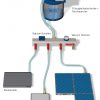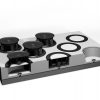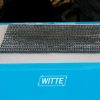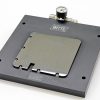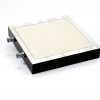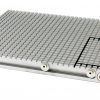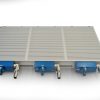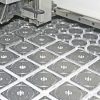When processing sensitive workpieces, filigree strips or extreme undercuts are a challenge for reliable workpiece clamping. The Weiguss mould clamping process from Witte opens up the possibility of securely clamping sensitive components and processing them mechanically. The component is held in place by a low-melting bismuth alloy.
Especially with filigree, complicated components that have a tolerance of less than a hundredth, dimensional accuracy is the top priority. When working with the Weiguss mould process from Witte, such tight milling tolerances are easily adhered to.
The semi-finished product to be machined is first clamped onto a vacuum clamping chuck and the upper half of the workpiece is conventionally milled.
After a moulding compound has been created from the Weiguss bars by heating them to around 70 degrees Celsius, the workpiece that has just been machined is "filled up". The Weiguss is poured into the component like water, whereby the liquid metal gets into all undercuts and cavities.
During the solidification process, the moulding compound expands by around 0.6 percent. This creates a tension effect.
If reference points and reference surfaces have also been milled into the Weiguss mould, the workpiece and the mould can be mounted together and machined in one clamping process
At the end of the machining process, the finished workpiece is released out of the mould compound by putting it in hot water at more than 80 degrees Celsius. The mould compound does not mix with water, nor does its mass decrease. It solidifies into a lump so that the Weiguss can be melted and reused as often as desired. Only the chips produced by milling and the slag produced during melting are lost.
Status: May 2019
